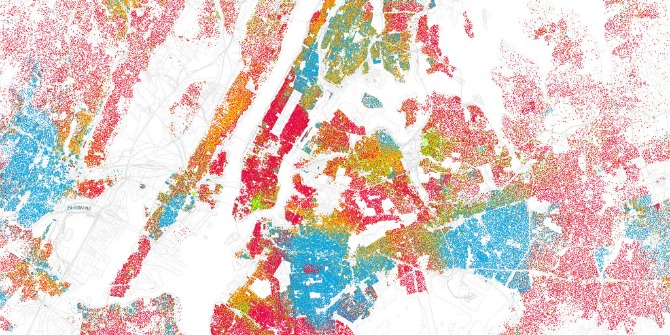Strengthening Communities with Neighborhood Data examines the role that data-based development approaches can have in shaping sound public and social policy. With a variety of case studies and a sound methodology, Susan Marie Martin writes that this is a comprehensive policy guidebook that provides a critically rich exploration of the hows and whys of data-generated policy development.
 Strengthening Communities with Neighborhood Data. G. Thomas Kingsley, Claudia J. Colton, Kathryn L. S. Pettit. Urban Institute. 2014.
Strengthening Communities with Neighborhood Data. G. Thomas Kingsley, Claudia J. Colton, Kathryn L. S. Pettit. Urban Institute. 2014.
In Victorian London the social survey was born when it became apparent that quantitative data, such as that collected by governments in a census survey, could not address the ills of that city’s impoverished neighbourhoods. Furthermore, qualitative data provided by middle class bureaucrats formed only part of the picture and, often, a biased one at that. In order to contextualise both problems and solutions, social surveys in the form of interviews with residents themselves were proven to be more effective. Finding themselves at a similar crossroads in late twentieth century America, researchers and community activists began to question how best to address the ills of that country’s impoverished neighbourhoods. Indeed, after decades of reform efforts, like much of the ‘developed’ world, America remained haunted by centuries of the identification of social ills and attempts to address them and resolve them, often with limited success.
In the introduction to Strengthening Communities with Neighborhood Data, the reader learns that the efforts started in America in the nineteenth century, and accelerated across the twentieth into various concerted movements geared toward reform, needed retooling. These include programmes which are all too familiar: ‘urban renewal’, ‘model cities’, and ‘community development’, all of which must be added to the ‘regeneration schemes’ of Europe. All are undeniably positive, full of action and promise, fuelling future-tense narratives of change for the better, but too often they ignore the real needs of the community they intend to serve. Sadly, this becomes cyclical: social and public policies generate the forms of data they were designed to eliminate. In response to this cycle of policy-programme-failure in America, this comprehensive text published by the Washington-based Urban Institute, provides a critically rich exploration of the hows and whys of data-generated policy development.
The timing of this book is particularly relevant considering the failures of many such programmes are being exacerbated by the global economic downturn and property bubbles that burst on both sides of the Atlantic. When combined with the compromises presented by ‘austerity’ governance, a book about effective data-based approaches is even more timely. These approaches are, the reader learns, relatively recent. It is work that uses community indicators such as living conditions and resources; these may include not only the usual information about education and health, but also, intriguingly, measures of a community’s “political voice”. The term ‘neighborhood’ is broadened from that defined by government-drawn boundaries. This point is stressed by the authors: analysts must use “flexible and overlapping geographic units” that incorporate “multiple perspectives into delineating place-based communities” relevant to the issue under study. Vitally, this approach also makes room for the “appreciation” of contested spaces and local knowledge.

The book is comprised of chapters written by the three authors, and each chapter is accompanied by essays from an extensive list of contributors to extend the foundational content of the chapter. One essay in particular sheds light on the range of data needed to address what ails a community beyond that which is visible. This contribution is from Hedy Chang, director of a national initiative designed to address chronic school absenteeism and is aptly titled “A Solvable Problem Hidden in Plain View”. Chang describes how chronic student absences impact not only the lives and futures of the students and schools, but, ultimately, the community beyond the school’s walls. Community-based initiatives, according to Chang, can help schools to conduct the research needed to identify and remedy “local attendance barriers” which may be less obvious than research on proper crosswalks. She stresses that research is also needed to identify the success stories of schools in troubled neighbourhoods so that replication of local programming that works may be carried out at other schools. Ultimately, she offers, what might be thought of a school-based problem is not “created or solved by schools alone”.
For those interested in the potential of information and communication technologies in this area of research and policy development, the essay “Mashup City” by Greg Sanders, an information architect and a technical director at the University of Chicago, is invaluable. Not only is the technical jargon deconstructed, but the chapter serves as a guide for using the internet, datasets and ICT that extends to other areas of social research and action. Despite the opportunities ICT has opened up for researchers and activists, Sanders reminds the reader that a digital divide still operates for organisations as well as individuals. He goes on to make a strong case for “mission-driven” organisations to adopt a do-it-yourself (DIY) approach to incorporate technology that allows them to convert raw data that is readily accessible into “high-value retail information tools” that will underpin sound policy decisions. Herein lays the value of an essay that makes its case persuasively, while serving as the very guidebook for the DIY-approach proposed.
The entire text moves in this direction toward a close that includes the ‘how-to’ of quality analysis, and a look to the “way forward”, all combining to make it a ‘go-to’ methodology text, source of case studies and policy guidebook. After first cracking the spine, I asked myself if, with a focus on American cities, how much of the work proposed would be ‘portable’ or transferable to other countries, continents and regions. The answer is that the ideas shared can make those journeys. Policy makers everywhere will serve stakeholders more effectively by adopting strategies that embrace the notion that neighbourhoods “matter for the people who live in them”. Yet, the authors remind us, this simple and seemingly obvious notion remains “remarkably contentious”. Despite the challenges, they remain optimistic, but not complacent, acknowledging that the text represents “advanced practice” and “sophisticated applications few would have expected possible 20 years earlier”. All the more reason why, once again, this is a resource poised to transcend borders and prompt conversations globally.
Susan Marie Martin holds a PhD in Applied Social Studies (Interdisciplinary) from University College Cork (National University of Ireland). Her research focuses on the impact of modernity and gentrification on the urban poor, particularly women who eke out subsistence earnings as street traders. She is an international educator, currently dividing her time between Ireland and the Middle East. Her thoughts on tangible and abstract markets, and the urban poor may be followed on Twitter @smariem13. Read more reviews by Susan.







